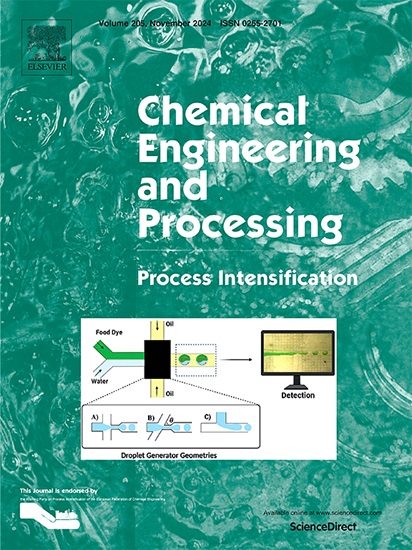Dual modification of red rice starch: Combining hydrothermal pretreatment with acid hydrolysis for the production of nanomaterials
IF 3.8
3区 工程技术
Q3 ENERGY & FUELS
Chemical Engineering and Processing - Process Intensification
Pub Date : 2025-03-27
DOI:10.1016/j.cep.2025.110292
引用次数: 0
Abstract
This study evaluated the combination of acid hydrolysis with hydrothermal pretreatment (HPT) for the production of nanomaterials using red rice starch. Native red rice starch (A0) was subjected to HPT in an autoclave at 121°C/10 min (A3) or cooked at 100°C/10 min (A4) and then hydrolyzed with 3.16M sulfuric acid at 25°C for a period of 5 days. The A3 treatment enhanced acid diffusion, leading to the efficient production of starch nanomaterials with a diameter of 106.97 nm. This process resulted in a crystallinity of 31.94%, a higher degree of polymerization of amylopectin (DP ≥ 37: 31.39–34.98%), and a yield of 33.48% on the third day, surpassing A0′s 10.12%. These characteristics classify A3 as starch nanocrystals (SNC). In contrast, A4 exhibited an increased diameter of 260.81 nm, and crystallinity remained in the range of 15%. It is classified as starch nanoparticles (SNP) and displayed higher gelatinization temperatures due to amorphous regions. DP was most affected by A4 with lower values DP ≥ 37 (25.68-30.16%) throughout acid hydrolysis, confirming the lower crystallinity. Finally, it was found that autoclaving was efficient as a pretreatment for native red rice starch to produce SNC through acid hydrolysis in a reduced time.

红米淀粉的双重改性:水热预处理与酸水解相结合制备纳米材料
研究了酸水解与水热预处理(HPT)相结合的红米淀粉纳米材料制备工艺。原生红米淀粉(A0)在121°C/10 min (A3)的高压灭菌器中进行HPT处理,或在100°C/10 min (A4)下进行蒸煮,然后在25°C下用3.16M硫酸水解5天。A3处理增强了酸的扩散,有效地生成了直径为106.97 nm的淀粉纳米材料。该工艺的结晶度为31.94%,支链淀粉的聚合度较高(DP≥37:31.39 ~ 34.98%),第三天的产率为33.48%,超过A0的10.12%。这些特征将A3归类为淀粉纳米晶体(SNC)。A4的直径增加了260.81 nm,结晶度保持在15%左右。它被归类为淀粉纳米颗粒(SNP),并且由于无定形区域而显示出更高的糊化温度。在酸水解过程中,DP受A4的影响最大,DP值较低,≥37(25.68 ~ 30.16%),结晶度较低。最后,研究发现,高压灭菌是一种有效的预处理方法,可以在较短的时间内通过酸水解产生天然红米淀粉SNC。
本文章由计算机程序翻译,如有差异,请以英文原文为准。
求助全文
约1分钟内获得全文
求助全文
来源期刊
CiteScore
7.80
自引率
9.30%
发文量
408
审稿时长
49 days
期刊介绍:
Chemical Engineering and Processing: Process Intensification is intended for practicing researchers in industry and academia, working in the field of Process Engineering and related to the subject of Process Intensification.Articles published in the Journal demonstrate how novel discoveries, developments and theories in the field of Process Engineering and in particular Process Intensification may be used for analysis and design of innovative equipment and processing methods with substantially improved sustainability, efficiency and environmental performance.

 求助内容:
求助内容: 应助结果提醒方式:
应助结果提醒方式:


